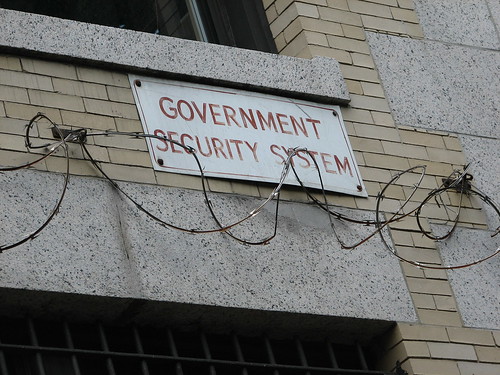I’ve said it a million times before: I don’t care if you switch to $FooFramework, as long as you have the same people executing it with the same skillset, the results will be the same. Last week and for the near-term, it’s a new bill to replicate the tenets of FISMA and the NIST framework thereof.
Last week, Representative Langevin introduced HR 5983, the “Homeland Security Network Defense and Accountability Act of 2008”. Some press on the bill:
Now the big question for me on this bill (and really, any proposed law) is this: How does this provide anything above and beyond what is already required by FISMA, OMB policies, and NIST guidelines? My short analysis: Not much, and Rep Langevin is just “stirring the pot” with the big spoon of politics.
HR 5983 requires the following:
- Re-establishes the role and staffing requirements for the CIO, including network monitoring
- Testing the DHS networks using “attack-based” protocols
- IG audits and reporting
- Adding responsibility for contractor systems
Again, nothing new here that isn’t required already. The only benefit to this bill that I see is that if it’s law, the Executive Branch has to request the funding in their budget request and Congress has to (maybe) fund it. It isn’t that DHS doesn’t have the in-house expertise–they own US-CERT. It’s not that they have a lack of smart people–they own the Security Line of Business. It’s that there are only so many hours in the day to get things done, and DHS has had lots of work since their creation in 2002.
A little bit of peeking behind the security kimono at DHS is in order. DHS consists of subagencies, known as Operational Elements, such as TSA, ICE, CBP, etc. The heads of these agencies are peers to the DHS CIO and have their own CIO and CISO, even though that’s not what they’re called. See, the OEs do not have to listen to the DHS CIO, and that’s a huge problem. Last year, DHS made the DHS CIO the budget approver for the OE’s IT budgets, which is a step forward, but still there is much room for improvement. That’s something that Congress can fix.
Now it just isn’t a “Government IT Security News Day” without a comment from Alan Paller of SANS fame…
“One story is missing from this issue because the press hasn’t picked it up yet. Under Chairman Langevin of Rhode Island, the US House of Representatives Subcommittee on Emerging Threats and Cybersecurity just approved a new bill that changes how security will be measured, at least at the Department of Homeland Security. This is the beginning of the end of the huge waste under FISMA and the start of an era of continuous monitoring and automation. Long overdue. Look for news stories over the coming days.
Alan”
Like I say sometimes, I’m a bear of little brain and a recovering infantryman, but why is the answer to a law to make another law saying the same exactly the same thing. All I have to say is this: You’re not on Slashdot, you actually have to read the bill before you comment on it. I didn’t see anything that supports what Alan’s saying. =)

Capitol at Sunset by vgm8383.
To me, the very interesting thing about this bill is this provision:
“Before entering into or renewing a covered contract, the Secretary, acting through the Chief Information Officer, must determine that the contractor has an internal information systems security policy that complies with the Department’s information security requirements, including with regard to authentication, access control, risk management, intrusion detection and prevention, incident response, risk assessment, and remote access, and any other policies that the Secretary considers necessary to ensure the security of the Department’s information infrastructure.”
I have an issue with the language of this provision. It’s one of scope.
But perhaps an explanation is in order. Most (OK, mabye half or a little bit more, this isn’t a scientific number) government IT systems are contractor-operated. These contractors have “Government data” on their corporate networks. Some of this is fairly benign: contracting collateral, statements of work, staffing plan, bill rates, etc. Some of this is really bad: PII, Privacy Act data, mission data, etc. Some of this is “gray area”: trouble tickets, event data, SIEM data, etc.
Now taking this back to cost-effective, adequate security, what the Langevin bill means is that you’re taking the FISMA framework and applying it to all contractors without any bounds on what you consider within your realm of protection–ie, according to the language of the bill, if I’m any contractor supporting DHS in an outsourcing engagement, you can audit my network, whether or not it has Government data on it. This is a problem because your oversight cuts into my margins and in some cases does not provide the Government with the desired level of security.
My response as a contractor is the following:
- Increase my rates to compensate for the cost of demonstrating compliance
- Do not bid DHS contracts
- Adopt a policy that says that DHS policies apply to the systems containing government mission data and meta-data
- Charge the Government at Time and Materials for any new requirements that they levy on you for mitigation
Unfortunately, this is a game that the Government will win at with respect to controlling the contractor’s network and lose at with respect to cost.
Good contractors understand the liability of having separation between Government data and their own network. Back in my CISO role, that was the #1 rule–do not putGovernment data on the corporate network or “cross the streams” (Thanks, Vlad). In fact, I wrote a whole chunk of blog posts last year about outsourcing, go check them out. In fact, we would give to the customer anything that could be built in a dedicated mode specifically for them. The dedicated network sections used the customer’s policy, procedures, standards, and they got to test them whenever they wanted. In back of that was a shared piece for things that needed large economy of scale, like the STK 8500 and the NOC dashboards to put all the performance data on one screen.
Having said that, some data does need to cross over to the contractor’s network (or, even better, a separate management network) in order to provide economy of scale. In our case, it was trouble tickets–in order to split field technicians across different contracts to keep them billable, the only cost-effective way to do this is to have tickets go into a shared system. Any other solution costs the Government a ton of money because they would be paying for full-time field techs to be on-site doing nothing.
The problem is that our guidance on contractor systems is grossly outdated and highly naive. The big book of rules that we are using for contractor security is NISPOM. Unfortunately, NISPOM only applies to classified data, and we’re left with a huge gap when it comes to unclassified data.
What we need is the unclassified version of NISPOM.
The NIST answer is in section 2.4 of SP 800-53:
The assurance or confidence that the risk to the organization’s operations, assets, and individuals is at an acceptable level depends on the trust that the authorizing official places in the external service provider. In some cases, the level of trust is based on the amount of direct control the authorizing official is able to exert on the external service provider with regard to the employment of appropriate security controls necessary for the protection of the service and the evidence brought forth as to the effectiveness of those controls. The level of control is usually established by the terms and conditions of the contract or service-level agreement with the external service provider and can range from extensive (e.g., negotiating a contract or agreement that specifies detailed security control requirements for the provider) to very limited (e.g., using a contract or service-level agreement to obtain commodity services such as commercial telecommunications services).
Hmmm, in a classic ploy of stealing lines from my Guerilla CISO Bag-o-Tricks ™, NIST has said “Well, it depends”. And yes, it depends, but how do you impement that when OMB dictates that what NIST says is THE standard?
Similar Posts:
 No Comments »
No Comments » Posts RSS
Posts RSS





